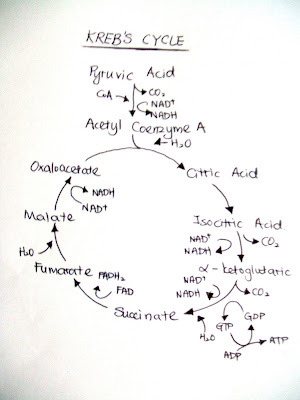1. Kreb's Cycle was first worked out by Sir Hans Krebs in 1937.
2. It is also called the Tricarboxylic Acid Cycle or Citric Cycle.
3. Kreb's Cycle also take place in aerobic conditions.
4. Pyruvate will give out CO2, converting NAD+ to NADH and react with Coenzyme A to form Acetyl Coenzyme A.
5. Acetyl Coenzyme A react with Oxaloacetate to form Citrate, catalysed by citrate synthetase enzyme.
6. Citrate rearrange itself to become isocitrate, catalysed by Aconitase enzyme.
7. Oxidative decarboxylation of isocitric acid produces alpha-ketoglutaric acid. CO2 is released, NAD+ is converted into NADH.
8. Oxidative decarboxylation of alpha-ketoglutaric acid will produce succinic acid. CO2 and NADH formedGTP is produced before hydrolysed into GDP, producing energy which is used for phosphorylation of ADP to ATP.
9. Succinate oxidised to fumarate. FADH2 is formed from FAD.
10. Fumarate is hydrated to malate.
11. Malate is oxidised to produce oxaloacetate again. NAD+ is converted to NADH.
12. The whole cycle began again.
Importance of Kreb's Cycle
1. Forms 6C compound (citrate) that can be oxidised to produce CO2, reduced coenzyme and energy.
2. Produces NADH and FADH2.
3. Forms GTP.
4. Synthesise substances such as amino acids, glycerol, chlorophyll and fatty acids.

No comments:
Post a Comment